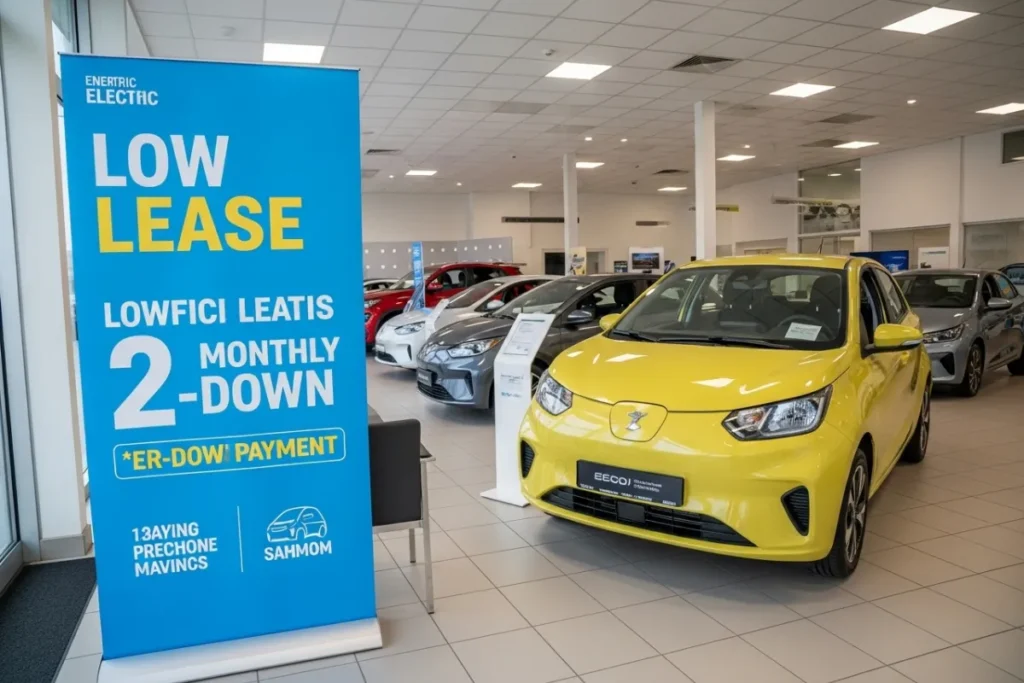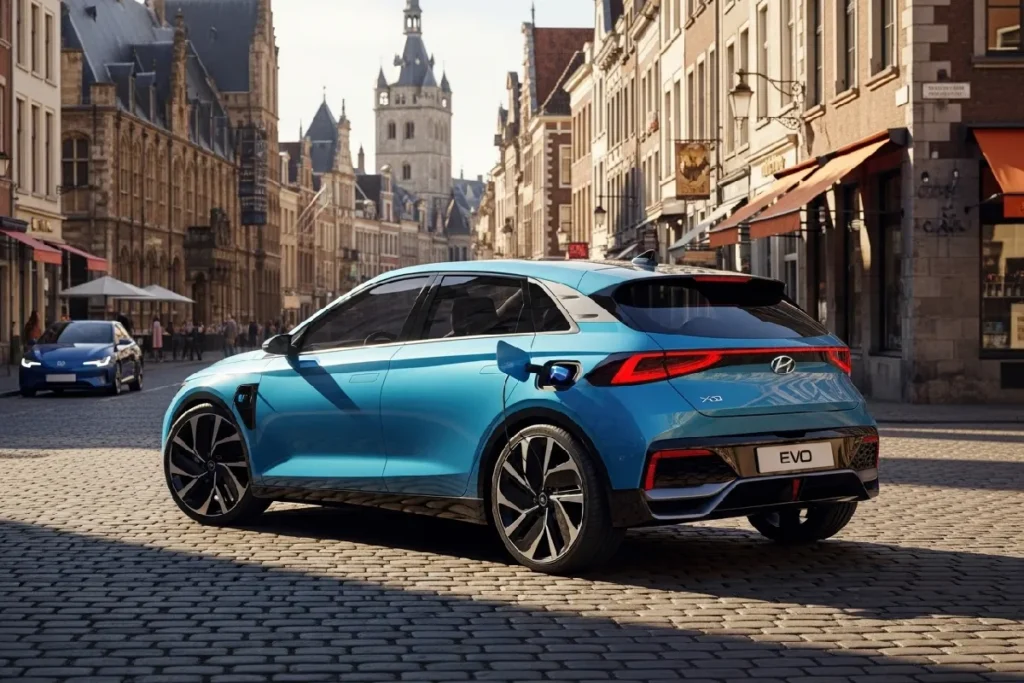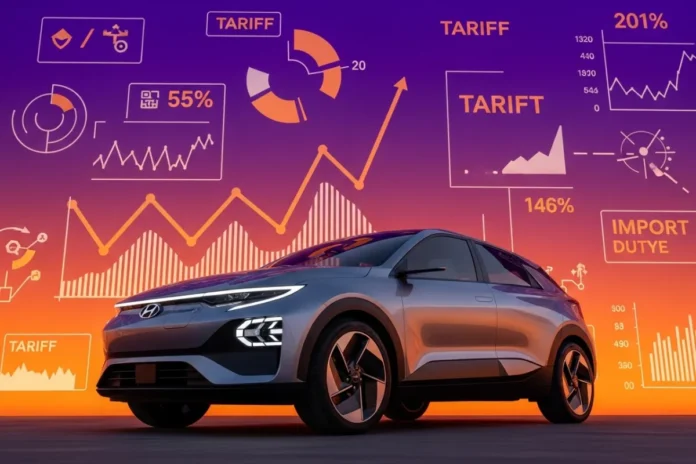As new U.S. tariffs threaten to upend the auto market, Hyundai and Kia are executing a brilliant counter-move. This article breaks down their multi-layered strategy, from aggressive lease deals to a new wave of lower-priced EVs, designed to shield consumers and secure their dominance.
Table of Contents
Introduction
That jaw-dropping $179-a-month lease on a new IONIQ 5 isn’t just a fleeting promotion; it’s the opening move in a masterclass on how to navigate a trade war. As new U.S. auto tariffs threaten to upend the electric vehicle market, Hyundai and Kia are not just bracing for impact—they are executing a brilliant counter-offensive designed to turn a threat into a competitive edge. This is their playbook for winning the new era of EVs.
This deep dive will dissect their multi-layered strategy. We will explore how they are using aggressive leasing and price stability as a short-term shield, while their long game focuses on a multi-billion-dollar U.S. production hub in Georgia. We’ll also examine their parallel push into Europe’s affordable EV market and explain how this comprehensive plan, centered on a new fleet of lower-priced EVs, ultimately benefits car shoppers and is set to reshape the entire industry.
The Tariff Gauntlet: Why the New U.S. Policy Is a Major Threat
The global auto industry was put on high alert when the U.S. announced a sweeping new set of tariffs, creating a formidable challenge for nearly every carmaker. The headline-grabbing measure was the staggering 100% tariff on electric vehicles imported from China, effectively walling them off from the American market. But the impact runs far deeper. The policy also includes significant tariff hikes on critical EV components like lithium-ion batteries (from 7.5% to 25%) and permanent magnets, which are essential for EV motors. This creates a ripple effect that extends well beyond Chinese brands.
For automakers like Hyundai and Kia, the threat is both direct and indirect. While their vehicles are designed and engineered in South Korea, popular models like the award-winning IONIQ 5 and Kia EV6 are currently imported into the United States. This immediately exposes them to import-related cost pressures. More critically, their global supply chain, like that of most automakers, relies on components and raw materials sourced from or processed in China. The increased cost of batteries and other parts threatens to inflate the production cost of every EV they build, regardless of its final assembly point.
This new reality forced a strategic acceleration. The tariffs weren’t just a hurdle to overcome; they became the catalyst that sharpened Hyundai and Kia’s focus on a pre-existing game plan. The challenge of navigating this complex trade landscape has compelled them to fast-track their pivot toward regional production and, most importantly, the development of lower-priced EVs capable of absorbing potential cost increases and capturing a new segment of the market.

The Short-Term Shield: Aggressive Leasing and Price Stability
While building factories is a long-term solution, Hyundai and Kia are deploying a brilliant and immediate financial strategy to keep their EVs moving off dealership lots. Their primary weapon is the aggressive use of leasing incentives, which allows them to deftly leverage a key provision in the Inflation Reduction Act. While their imported models don’t qualify for the consumer-facing $7,500 tax credit, the commercial EV tax credit is still available to the company’s financing arm when it purchases the vehicles to lease them. Hyundai and Kia are then passing that full $7,500 savings directly to the customer in the form of massively reduced monthly payments. This is how they can offer jaw-dropping deals, like an IONIQ 5 lease for as low as $179 a month, effectively neutralizing the tax credit disadvantage and making their EVs one of the best bargains on the market.
Complementing this leasing push is a commitment to price stability. In a market where tariff news could easily justify price hikes, Hyundai and Kia have chosen to hold the line on the sticker prices for their U.S. lineup. This sends a powerful message of confidence and value to consumers, building brand trust at a time of industry-wide uncertainty. Together, these tactics form a crucial bridge strategy. They maintain strong sales momentum and high brand visibility, keeping shoppers engaged and loyal while the company’s long-term manufacturing plans in Georgia power up. It’s a short-term shield that ensures they don’t lose ground in the competitive American EV race.
The Long Game: U.S. Production and a New Fleet of Lower-Ppriced EVs
While leasing deals provide immediate relief, Hyundai and Kia’s long-term strategy is rooted in American soil. The centerpiece of this plan is the Hyundai Motor Group Metaplant America (HMGMA), a massive $7.6 billion state-of-the-art facility under construction in Georgia. Designed to produce up to 300,000 EVs annually, this “Metaplant” is the ultimate tariff-buster. Once models like the three-row IONIQ 7 SUV roll off its assembly line, they will be classified as U.S.-made, making them fully eligible for the $7,500 federal tax credit without any leasing workarounds. This single investment fundamentally changes their competitive position in the American market.
However, the strategy isn’t just about relocating production—it’s about expanding the product line. The true genius of the plan lies in leveraging the brand’s flexible Electric-Global Modular Platform (E-GMP) to launch a new wave of lower-priced EVs. The recently unveiled Kia EV3, a compact electric SUV with a target price around $35,000, is the first shot in this new offensive. It will soon be joined by the sleek EV4 sedan, with Hyundai expected to follow with its own versions, likely badged as the IONIQ 3 and IONIQ 4. These vehicles are engineered from the ground up for affordability and are destined for production at the Georgia plant, creating a full spectrum of EV choices for every budget.
This multi-billion-dollar investment signifies a monumental shift. Hyundai and Kia are transforming from successful importers, vulnerable to the whims of international trade policy, into a deeply integrated local powerhouse. By building their most crucial vehicles and batteries in the U.S., they are not only insulating themselves from future tariffs but are also solidifying a long-term commitment to becoming a dominant force in the American EV landscape.

Hedging Their Bets: A Global Push into Europe’s Compact EV Market
While Hyundai and Kia are making a massive bet on the U.S., their global strategy is far from one-dimensional. A key part of their plan involves hedging those bets with an aggressive and parallel push into the European market. This diversification is a classic strategic hedge; by cultivating a strong presence on another major continent, they cushion themselves against potential slowdowns or unforeseen policy shifts in North America, ensuring a more stable and resilient global revenue stream. It’s a move designed to prevent them from being overly reliant on the success of a single market.
The European offensive is tailored specifically to local tastes and economic realities. Instead of leading with the larger vehicles favored by Americans, the focus is on a new generation of compact, highly efficient, and more affordable models. Kia is spearheading this with the stylish EV3 and the even smaller EV2, which is slated to target the highly competitive €25,000 (around $27,000) price point. This is a direct challenge to European stalwarts like Volkswagen, Renault, and Stellantis on their home turf, aiming to capture a segment of the market that prioritizes city-friendly dimensions and outright value.
This two-pronged approach demonstrates remarkable global agility. Hyundai and Kia aren’t creating a single, one-size-fits-all “affordable EV” template. Instead, they are astutely designing different types of lower-priced EVs to conquer different regional battlegrounds: rugged, tax-credit-ready SUVs for America and nimble, budget-friendly compacts for Europe. This ability to adapt and win on multiple fronts makes their overall strategy more robust and positions them for sustainable growth, no matter where the next market challenge arises.
| Region | Strategic Focus | Key Models | Target Segment |
|---|---|---|---|
| United States | – Large-scale investment- Focus on rugged SUVs- Designed for tax credit eligibility | Not specified | – SUV segment- Consumers seeking tax incentives |
| Europe | – Diversification strategy- Focus on compact, efficient, and affordable EVs | Kia EV3, Kia EV2 | – Urban drivers- Price-sensitive buyers- Target price: |
Conclusion
In the high-stakes chess match of global auto manufacturing, Hyundai and Kia have demonstrated that the best defense is a well-planned offense. Faced with the formidable barrier of U.S. tariffs, they have refused to be cornered. Instead, they’ve executed a sophisticated, multi-pronged strategy that insulates them from immediate harm while positioning them for long-term dominance. From the immediate financial ingenuity of their “leasing loophole” and steady pricing to the foundational, multi-billion-dollar investment in their Georgia Metaplant, every move has been deliberate and powerful. This strategy, reinforced by a parallel push into Europe, shows a global company operating with confidence and foresight.
Ultimately, Hyundai and Kia’s response provides a clear answer to how established automakers can thrive amidst market disruption. Their core message is that the path forward is not through premium-priced, exclusive vehicles, but through accessible, smartly engineered, lower-priced EVs for the mass market. This is their shield against tariffs and their spearhead for capturing future growth.
For industry analysts, it’s a masterclass in turning a crisis into an opportunity. For competitors, it’s a new benchmark for price and production that cannot be ignored. But for the American car buyer and EV enthusiast, the implication is the most compelling. As these tariff-proof models begin rolling off U.S. assembly lines, Hyundai and Kia are not just selling cars; they are redrawing the map of EV accessibility. The question is no longer if high-quality, affordable electric vehicles will arrive, but rather who will be able to keep pace with the standard they are now setting.


